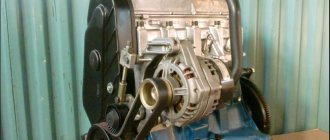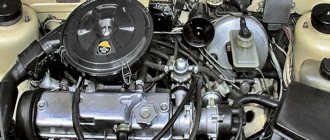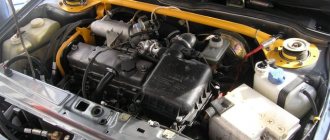The 1G FE engine is an in-line six-cylinder petrol engine that was designed and manufactured by specialists from the Japanese automaker Toyota in 1988. It replaced the 1G EU motor.
This motor combines simplicity of design, reliability and excellent dynamic performance. 1G FE engines were installed on a dozen different Toyota models. In 2007, this modification of the power unit was discontinued.
Specifications
Download .xls file
xls
Download picture
Send by email
| OPTIONS | MEANING |
| Years of manufacture | 1988 – 2007 |
| Engine weight, kg | 180 |
| Cylinder block material | cast iron |
| Supply system | injector |
| Type | in-line |
| Working volume | 2 |
| Power | 135 horsepower at 5600 rpm |
| Number of cylinders | 6 |
| Number of valves per cylinder | 4 |
| Piston stroke, mm | 75 |
| Cylinder diameter, mm | 75 |
| Compression ratio | 42530 |
| Torque, Nm/rpm | 180 -200/4400 |
| Environmental standards | EURO 3 |
| Fuel | AI 92-95 |
| Fuel consumption | 14 l/100 km in the urban cycle |
| Oil | SAE 0W-30 and higher |
| How much oil is in the engine | 42404 |
| When replacing, pour | 4 liters |
| Oil change carried out, km | 15 thousand |
| Engine life, thousand km - according to the plant - in practice | 400+ 500+ |
1G FE engines are installed on the Toyota Mark 2 X90, Soarer Z20, Altezza, Verossa, Lexus IS 200 and Crown GS130.
Features of "SuperNail-1GE"
Engine 1jz gte toyota
Fiber network topology
- "point-to-point";
- “point-to-point over one fiber”;
- "ring";
- “redundant ring”;
- “communication over one fiber between several communication points.”
An example of the operation of a point-to-multipoint network using SuperGvozd-1GE and broadband access equipment from other vendors. View the report To organize communication, you can use one or two single-mode or multimode optical fibers (depending on the installed SFP module). To organize communication over one optical fiber, semi-sets are used with an optical receiver and transmitter combined in one SFP transceiver. In this case, transmission and reception in one direction are carried out at different wavelengths of optical radiation, which makes it possible to ensure the maximum possible length of the regeneration section, working on one fiber. The maximum length of the regeneration section depends on the type of optical fiber and the installed SFP module and varies from 10 to 80 km. The minimum length of the regeneration section is zero. Redundancy Equipment semi-sets designed for operation at intermediate communication points provide 100% redundancy of the group stream transmitted over optical fiber, which allows for uninterrupted transmission of the group stream in the event of a fiber break in one of the sections of the fiber-optic line or in the event of a failure food at one of the communication points. Redundancy is provided by 2 SFP optical transceivers and a built-in E1 flow cross-switch. Management Network configuration, control and management of semi-sets is carried out either locally directly at the communication point or remotely using software via the Ethernet interface. Each semi-set has its own IP address specified by the user. From one communication point you can monitor and control all local and remote semi-sets in test mode. Test control mode involves a short-term change (5 minutes) of the semi-set settings. At the end of the test time, all settings set by hardware are restored.
Station Alarm The alarm output is a normally closed and normally open dry relay contact protected by a fuse.
Execution of semi-kits With power supply ~220V or -60V:
| Order code | Product name | Purpose |
| RTC.52.1 | Basic semi-set “SuperGvozd-1GE”, 4 SFP slots, 1Gb Ethernet, 24E1, 12RS-232. Power supply: 60 V. SFP modules must be ordered separately | Ring transmission with redundancy: 24E1, 2 Ethernet 1 Gbit/s each, Ethernet 100Tx - 100 Mbit/s, 12 RS-232 Power supply - 60V. SFP modules must be ordered separately. |
| RTC.52.2 | Basic semi-set “SuperNail-G”, 4 SFP slots, 1Gb Ethernet, 24E1, 12RS-232, AC 220 V Power supply - 220 V, 50 Hz. SFP modules must be ordered separately | Ring transmission with redundancy: 24E1, 2 Ethernet 1 Gbit/s, Ethernet 100Tx - 100 Mbit/s, 12 RS-232 Power supply - 60V. SFP modules must be ordered separately. |
| RTC.52.3 | Basic semi-set “SuperNail-1GE”, 4 SFP slots, 8E1, 12RS-232 Power supply: DC - 60V | Ring transmission with redundancy: 8E1, 2 Ethernet of 1 Gbit/s each, Ethernet 100Tx - 100 Mbit/s, 12 RS-232 Power supply - 60V. SFP modules must be ordered separately. |
| RTC.52.4 | Basic semi-set “SuperNail-1GE”, 4 SFP slots, 8E1, 12RS-232, Power supply: ~220V, 50 Hz OUT OF PRODUCTION. REPLACEMENT - FEED RTC.14.55 | Ring transmission with redundancy: 8E1, 2 Ethernet 1 Gbit/s each, Ethernet 100Tx - 100 Mbit/s, 12 RS-232 Power supply - 220V, 50Hz. SFP modules must be ordered separately. |
| RTC.14.55 | Semi-set board 2 SFP slots 1.25 Gbit/s, 24E1 Power: ~220V, 50 Hz Download description | Ring transmission with redundancy: 24E1+ 4 Ethernet 1Gbit/s each (Ethernet Switch 4×10/100/1000 Mbit/s) 8xE1 allocation. Case with motherboard: width 19″, height 1.5U. Power supply: ~220V, 50 Hz. SFP modules must be ordered separately. |
| RTC 52.5 | Basic semi-set “SuperNail-1GE”, 4 SFP slots, 16E1, 12RS-232 Power: DC - 60V | Ring transmission with redundancy: 16E1, 2 Ethernet 1 Gbit/s each, Ethernet 100Tx - 100 Mbit/s, 12 RS-232 Power supply - 60V. SFP modules must be ordered separately. |
| RTC 52.6 | Basic semi-set “SuperNail-1GE”, 4 SFP slots, 16E1, 12RS-232, AC 220V | Ring transmission with redundancy, SFP: 16E1, 2 Ethernet 1 Gbit/s each with SFP, Ethernet 100Tx - 100 Mbit/s, 12 RS-232 Power supply - 220V, 50Hz. SFP modules must be ordered separately. |
For multiplexer configuration, we offer you a large selection (more than 200 models) of reliable SFP modules.
Certificate of conformity: No. OS-1-SP-1539 until 07/04/2020
Peculiarities
The 1G engine has a displacement of two liters and develops a power of 135 horsepower. Thanks to the use of a reinforced cylinder head and a connecting rod group made of heavy-duty alloy, this engine has established itself as a fairly reliable and durable engine.
Without major repairs, 1G engines, provided they are properly maintained, can run about 500 thousand kilometers. It is not uncommon for cars with 1G FE to have driven more than a million kilometers, which indicates the excellent reliability of this power unit.
One of the features of this engine is the presence of a belt drive gas distribution system. However, no decrease in the reliability of the power unit is noted. Timing belt breaks are very rare, while the advantages of such a solution are obvious.
The gear belt drive has made it possible to significantly reduce the cost of motor production, simplify motor maintenance, and the power unit itself is compact in size. The use of a special interference belt drive system eliminates the impact of the pistons on the valves when the belt breaks. Thus, even in the event of such a serious breakdown, the car owner will be spared the need for expensive major repairs.
The gas distribution circuit of the engine is made using DOHC technology; it has four valves per cylinder. This allows you to optimize the operation of the power unit and make the most of its dynamic potential.
This motor is characterized by smooth operation over a wide speed range. Despite the fact that the engine shows its peak power at 4,400 thousand revolutions per minute, already at 1,500 revolutions the engine produces more than 80 percent of its power.
The cylinder block is cast from cast iron, which ensures maximum strength and thermal stability of the engine. It must be said that when casting the cylinder block and cylinder head, a special alloy reinforcement technology was used, which made it possible to reduce the thickness of the cylinder walls without losing the reliability and durability of the engine. This made it possible to reduce the weight of the six-cylinder engine, and thanks to its small size it can fit even in a small engine compartment. The weight of the power unit is 180 kilograms, which is a record low for six-cylinder engines.
Advantages and disadvantages
The advantages of power units include:
- reliability and durability of the structure with timely maintenance;
- low noise level, no vibration during operation;
- simple design (versions of the 1G FE motor without a phase shifter);
- good power and traction parameters (only for Beams modification).
The disadvantages are:
- the lubrication system requires high quality oil;
- cutting off timing belt teeth at low temperatures;
- leakage of the frontal oil pump oil pump, which is driven by the timing belt;
- defects in oil pressure sensors;
- destruction of ignition system elements due to the age of engines;
- Dirt deposits in hydraulic compensators (on the Beams version);
- bending of valves when the belt breaks and low life of ignition coils (typical for the Beams modification).
Modifications
- Since August 1998, a new version of the motor has been released - 1G FE Beams. With VVT-i system and increased power of 160 hp. With. at 6200 rpm.
- In 1996, the 1G FE Beams engine was slightly restyled. The maximum power indicator increased to 140 horsepower, and the torque amounted to 185. The power characteristics were improved by reconfiguring the 1G FE Beams engine control unit and transferring the engine from 92 gasoline to AI 95. However, most car owners successfully operate their cars with this engine on A-92 gasoline, and there are no complaints about the reliability and dynamics of the car.
- In 1998, the engine was significantly changed. It received a new ShPG, an updated manifold with the ability to adjust geometry, an updated valve timing system, and a fully electronic throttle valve. Also on the 1G FE Beams the ignition system was changed.
A special feature of the modification of the 1G FE Beams engine is the absence of hydraulic valve clearance compensators, so for the 1G FE valves are adjusted every 20 thousand kilometers. Note that adjusting the 1G FE valves is not difficult and, with some experience, can be done independently by the car owner.
The restyling of the 1G FE Beams made it possible to increase engine power to 160 horsepower at 6200 engine speeds. The problem with the appearance of an oil leak from under the valve cover was eliminated and the oil pressure sensors were replaced, which also often failed and required expensive replacement.
The 1G FE Beams engine has proven itself exclusively on the positive side. Reliable, easy to operate and repair, with excellent dynamic and technical characteristics.
Its only drawback is low power. In the mid-2000s, it was possible to easily extract more than 200 horsepower from two liters of displacement, while even in the restyled version this engine produced only 160 horsepower. It was precisely because of obsolescence that this internal combustion engine was discontinued in 2007.
Maintenance schedule 1G FE 2.0 l/135 l. With.
The following intervals for replacing consumables are provided for the 1G FE engine:
- The timing belt must be replaced every 75,000 km, attachments after 50,000 km;
- It is recommended to adjust valve thermal clearances after 30,000 mileage;
- cleaning of the crankcase ventilation is provided every 2 years;
- The manufacturer recommends replacing the engine oil after 7,500 km along with the oil filter;
- the fuel filter should be replaced after 40,000 miles;
- The air filter must be replaced annually;
- after the coolant is packaged from the factory, the additives inside the antifreeze lose effectiveness after 40,000 km;
- the life of spark plugs in the DIS-4 engine system is 20,000 mileage;
- A burnout in the intake manifold is possible after 60,000 km.
Replacing the 1G FE belt
The first version (1988 - 1998) is considered more reliable, the second version (1998 - 2005) is economical, high-torque and responsive. In rear-wheel drive cars, with filter replacement, you will need 4.0 liters of SJ/SL class lubricant exactly, and in all-wheel drive cars, 4.2 liters of 5W20, 5W30, 10W30 oil.
In the DIS-6 ignition system (since 1998), spark plugs, all other things being equal, will last longer than 30 thousand km instead of 20.
Malfunctions
| FAULT | CAUSE |
| Increased oil consumption. | This is typical for stuck oil scraper rings. In this case, the repair consists of decoking the engine or installing new rings, valve stem seals and liners. We recommend using the appropriate repair kit, which will greatly simplify the repair work. |
| The appearance of oil leaks. | This is a typical failure, especially for engine modifications before the 1998 1G FE Beams restyling. A leak appeared from under the oil sensor, which was difficult to eliminate. The cause of the problem was the oil sensor itself, which lost its seal and leaks appeared. The difficulty is that getting to the sensor and replacing it is not so easy. It is necessary to lift the engine or remove attachments. |
| There are problems with oil pressure in the internal combustion engine system. | The reason is a failed oil sensor. We recommend checking the pressure in the system and replacing the failed sensor. |
| The appearance of floating idle speed. | The idle air valve and throttle valve need to be checked. This work should be performed exclusively by a specialist, which will ensure that engine problems are completely eliminated. |
Engine problems and shortcomings
Serious breakdowns do not occur in 1G FE. Low engine speed and the absence of electronic devices in the stock version make the internal combustion engine repairable and reliable. However, do not forget to change the engine oil and filter every 7,500 - 10,000 km or once a year
This is especially important for BEAMS. Dirty or low-quality oil clogs the solenoid valves, which leads to system malfunctions
And changing valves is expensive.
In the 1G-FE BEAMS internal combustion engine, when the timing belt breaks, the valve stems bend. To avoid major repairs, it is necessary to monitor the condition of the drive and change the belt along with the oil pump every 100,000 km. Spark plugs and fuel filter last no more than 20,000 km. During maintenance, it is also necessary to adjust the thermal clearance of the valves: for inlet valves 0.15 - 0.25 mm, for exhaust valves - 0.25 - 0.35 mm.
If you accelerate too much in winter without warming up the engine, you can get many problems, from oil leakage to cutting off the timing belt teeth. Lubricant leakage occurs through a faulty pressure sensor, stiffened rings and outdated valve stem seals. In the first releases of the 1G FE engine, the pressure sensor was the “weak link” - it malfunctioned and quickly broke down.
A flickering tachometer needle at idle, as with many engines, indicates a faulty throttle body or IAC sensor, a clogged throttle body, or fogging around the valve cover gasket.
On older units, oil consumption occurs: more than 1 liter per 1000 km. The problem arises when the oil receiver in the pan becomes clogged and the oil scraper piston rings become coked. To eliminate the malfunction, the engine must be completely cleaned, gaskets, bearings, worn oil seals and valve stem seals replaced, i.e. make minimal repairs.
With age, the ignition also malfunctions: in the 1G FE, the wires wear out and the distributor breaks. In the BEAMS model, the ignition coils need to be replaced.
Tuning
- The simplest option for increasing the power of a 1G FE engine is chip tuning, in which an additional control unit for the operation of the power unit is installed. As a result, it is possible to obtain a small increase in power, which, depending on the specific chip, can amount to 5-20 horsepower.
- The 1G FE Beams capital tuning program is popular, which involves installing a turbine, boost controller, intercooler, replacing the exhaust, engine control unit and exhaust system. As a result, it is possible to completely change the dynamic characteristics, raising the engine power to 300 horsepower. However, it should be noted that the resource of such a forced engine is significantly reduced.
- It is possible to replace the standard exhaust system of the 1GR FE engine, which allows you to add about 5 percent of power. There are many options for sports exhaust systems for Toyota cars. You just need to choose the option that suits your specific car and engine.
- Among the available tuning options for the 1G FE Beams, we can note the engine swap, which will allow you to install a turbocharged engine with a power of about 200 horsepower in a small engine compartment. The advantage of this option is the complete preservation of the resource of the power unit, and if it is possible to sell the old engine being replaced, the car owner will be able to significantly reduce his tuning costs.
Our offer
You can purchase a contract Toyota 1G-FE engine at an attractive price if you contact. We specialize in direct supplies of spare parts and components for foreign-made cars directly from Japan and Europe. We cooperate only with trusted suppliers and independently form batches of units that are in high demand. Our warehouses are located in Moscow, St. Petersburg, Novosibirsk, Irkutsk, Krasnoyarsk, and a number of other Russian cities. All engines that go on sale undergo a mandatory procedure for checking their technical condition at professional stands. By purchasing a unit from us and installing it in our service, you will receive a guarantee for a period of up to 100 days. All license plates are accompanied by documents that will allow you to go through the state procedure without any problems. registration with the traffic police.
To select the power unit you need from those available and fill out the order form, visit our catalog page: https://torens-auto.com/catalog/dvigatel_v_sbore/filter/torgovaya_marka-is-toyota/dvigatel-is-1g-fe/ apply/.
By calling +7 499 288 06 34 with additional questions, you can receive any necessary information.











